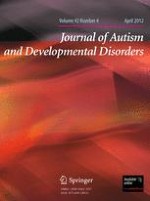01-04-2012 | Original Paper
IQ Predicts Biological Motion Perception in Autism Spectrum Disorders
Gepubliceerd in: Journal of Autism and Developmental Disorders | Uitgave 4/2012
Log in om toegang te krijgenAbstract
Biological motion is easily perceived by neurotypical observers when encoded in point-light displays. Some but not all relevant research shows significant deficits in biological motion perception among those with ASD, especially with respect to emotional displays. We tested adults with and without ASD on the perception of masked biological motion and the perception of direction from coherent and scrambled biological motion. Within the autism spectrum group, there was a large and statistically significant relationship between IQ and the ability to perceive directionality in masked biological motion. There were no group differences in sensitivity to biological motion or the ability to identify the direction of motion. Possible explanations are discussed, including the possible use of compensatory strategies in high IQ ASD.
